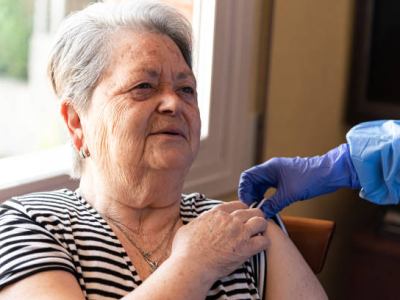Last season's influenza vaccination coverage in healthcare workers and pregnant women held ground over the past few years, according to new reports today from the US Centers for Disease Control and Prevention (CDC), including the first health facility flu vaccine coverage data from a new federal reporting requirement.
The needle didn't move much for vaccine coverage for pregnant women, from 50.5% in 2012-13 to 52.2% last year. But the proportion of those who received a clinician's flu vaccine recommendation compared with the season before rose more than 10 percentage points.
The CDC called that a promising finding, given that a doctor's recommendation is considered one of the strongest tools for improving coverage rates in pregnant and postpartum women.
CDC Director Tom Frieden, MD, MPH, addressed the findings today at an annual media briefing sponsored by the National Foundation for Infectious Diseases (NFID) to spotlight to the importance of annual flu vaccination ahead of the 2014-15 flu season. Other infectious disease experts also spoke at the event, held at the National Press Club in Washington, DC.
Today's briefing was also designed to raise awareness about a new pneumococcal vaccine recommendation for people ages 65 and older, first announced in August.
Reports on all three topics appear today in the latest issue of Morbidity and Mortality Weekly Report (MMWR).
Though many states are battling clusters of enterovirus D68 (EV-D68) infection, a relatively rare coldlike virus that can cause wheezing and breathing difficulties, flu levels in the United States are still very low.
Flu manufacturers expect to produce between 151 and 159 million doses of flu vaccine for the US market, and according to the CDC as of Sep 11, nearly 41 million doses have been distributed so far.
Vaccine uptake in health workers
The CDC uses several tools to survey flu vaccine uptake in healthcare workers, each designed to sift out different types of information. Reports from two of the systems appeared in separate MMWR reports, one based on an opt-in Internet survey of workers and one that centers on findings from a the new Centers for Medicaid and Medicare (CMS) reporting requirement, finalized in August 2011 and starting in January 2013.
Frieden said the findings from the two surveys were close, with the CMS one providing a good baseline for future years.
The report on coverage based on the CMS requirement found that 82% of healthcare workers were vaccinated against the flu, which Frieden said was encouraging. The data are from 4,254 hospitals in all 50 states and the District of Columbia, Hospitals report vaccine uptake for three groups: employees, licensed independent practitioners (LIPs), and students and volunteers.
Overall, 81.8% of the healthcare workers were vaccinated during the 2013-14 flu season. Levels were highest in employees—86.1%—and lowest in LIPs, at 61.9%, with results varying by state.
The CDC said data reporting has been shown to increase flu vaccine uptake in providers and that the findings provide a baseline to gauge future progress. It added that improvements in hospitals' ability to track LIP vaccination coverage might reveal higher vaccination in the seasons ahead.
The second study is based on findings from an opt-in Internet survey conducted for the CDC, a system that has been tracking flu vaccine uptake levels since 2010. Findings are based on a sample of 1,882 healthcare workers.
Overall coverage was 75.2%, up from 72.0% the previous season and 66.9% in the 2011-12 season, according to the CDC report. Levels were highest in physicians and those working in hospital settings. As in previous years, uptake was lower in assistants and aides and in health providers working in long-term care settings.
As expected, uptake was higher in facilities that had mandatory flu vaccine requirements, but researchers also found that uptake was high (80.4%) when facilities offered the vaccine at work for no cost for more than 1 day. Researchers concluded that strategies that combine flu vaccine promotion with offering easy access to the vaccine for more than 1 day might boost vaccine coverage in healthcare workers.
For both studies, overall uptake was below the healthcare worker flu vaccination level of 90% contained in the Healthy People 2020 goals.
Coverage in pregnant women
In a separate study on annual flu vaccine uptake in pregnant women, the CDC found that the 52.2% and 50.5% coverage in the most recent two seasons was well above the 46.4% and 44.0% levels reported in the previous two seasons. The Healthy People 2020 target for flu vaccine uptake in pregnant women is 80%.
CDC researchers found an increase in the number of women last season who received a provider recommendation, thought to be the best tool for increasing vaccine coverage in this group. According to the findings, 65.1% got a provider recommendation last season, compared with 54.6% the previous season.
Laura Riley, MD, director of labor and delivery at Massachusetts General Hospital, said at the briefing that the findings suggest doctors can still do more to speak to their pregnant patients about the safety of the vaccine and its ability to protect newborns during the first 6 months of life.
Pneumococcal vaccine in the elderly
The other MMWR study detailed an August recommendation from CDC vaccine advisors that adults age 65 and older receive the Prevnar 13 (PCV13) pneumococcal conjugate vaccine alongside the current 23-valent pneumococcal vaccine.
The 13-strain vaccine has dramatically driven down the disease burden in children, and adding the vaccine to the vaccine immunization schedule for older adults is thought to provide a boost in protection.
The Advisory Committee on Immunization Practices (ACIP) suggests that all seniors receive both vaccines. It says people age 65 and over receiving the vaccines for the first time should be immunized with PCV13 first, followed by a dose of the 23-valent vaccine 6 to 12 months later.
See also:
Sep 11 CDC flu vaccine distribution update
Sep 19 MMWR report on health worker flu vaccine uptake (Internet panel findings)
Sep 19 MMWR report on health worker flu vaccine uptake (CMS reporting requirement findings)
Sep 19 MMWR report on flu vaccine uptake in pregnant women
Sep 19 MMWR report on ACIP pneumococcal vaccine recommendation
Aug 14 CIDRAP News scan on ACIP pneumococcal vaccine recommendation




















